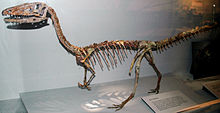腔骨龙属
| 腔骨龙属 | |
|---|---|

| |
| 位于克里夫兰自然历史博物馆的腔骨龙骨架 | |
| 科学分类 | |
| 界: | 动物界 Animalia |
| 门: | 脊索动物门 Chordata |
| 纲: | 蜥形纲 Sauropsida |
| 总目: | 恐龙总目 Dinosauria |
| 目: | 蜥臀目 Saurischia |
| 亚目: | 兽脚亚目 Theropoda |
| 科: | †腔骨龙科 Coelophysidae |
| 属: | †腔骨龙属 Coelophysis Cope, 1889 |
| 模式种 | |
| 鲍氏腔骨龙 Coelophysis bauri Cope, 1887
| |
| 种 | |
| 异名 | |
|
属异名
种异名 (鲍氏腔骨龙 C. bauri)
| |
腔骨龙属(学名:Coelophysis)又名虚形龙,是北美洲的小型、肉食性、双足恐龙,也是已知最早的恐龙之一。牠首先出现于三叠纪晚期的诺利阶[1]。
描述
[编辑]
腔骨龙是最早发现几副完整骨骼的恐龙。模式种鲍氏腔骨龙(C. bauri)是轻盈的恐龙,约有2-3米长,臀部高于1米高[2]。牠的属名是来自古希腊文的“κοιλος”(意即空心)及“φυσις”(意即形态),是取自牠那空心的四肢骨头。
腔骨龙的体型亦比艾雷拉龙及始盗龙更为衍化。腔骨龙的头部具有着大型洞孔,可帮助减轻头颅骨的重量,而洞孔间的狭窄骨头可以保持头颅骨的结构完整性。长颈部则呈S形。
腔骨龙的躯体与基本的兽脚亚目体型一致,但肩带则有一些有趣的特征,就是牠们有着叉骨,是恐龙中已知最早的例子。腔骨龙的每只手有四指,其中只有三指是有功能的,第四指则藏于手掌的肌肉内。
腔骨龙的骨盆及后肢与兽脚亚目的体型有少许差别。牠因开放的髋臼及笔直的脚跟关节,而被定义为恐龙。后肢脚掌有三趾,而后趾是不接触地面的。
腔骨龙的长尾巴有不寻常的结构,在其脊椎的前关节突互相交错,形成半疆直的结构,似乎可制止牠的尾巴上下摆动[3]。当腔骨龙快速移动时,尾巴就因而成为了舵或平衡物。
腔骨龙非常纤细,可能是种善于奔跑的动物。腔骨龙的头部长而狭窄,锐利的锯齿状牙齿显示牠们为肉食性,可能以小型、类似蜥蜴的动物为食[4]。牠们可能以小群体方式集体猎食[5]。
古生物学
[编辑]
腔骨龙是种肉食性动物。牠们的牙齿是标准的猎食性恐龙的牙齿,像剑一样并向后弯,牙齿的前后缘有着小型的锯齿边缘。
由于对腔骨龙的知识是主要来自美国新墨西哥州幽灵牧场的标本,有研究指可能当时有大量的腔骨龙聚集在这个地方。不过这却没有证据,这些集体化石只显示有大量的腔骨龙,连同其他的三叠纪动物,一同被埋葬于此。埋葬学提供了一些证据,指这些动物可能聚集在一起摄食、或从废弃的水坑中喝水、或捕食刚出生的鱼类,接着被突发性的洪水所埋葬。
由于在幽灵牧场的腔骨龙标本下腹中,发现有幼龙的标本,故有研究指牠们是有同类相食习性。但是于2002年的研究指这些标本其实是被曲解了,这些所谓幼年腔骨龙的标本其实是小型的伪鳄类,如黄昏鳄 ,故此没有任何证据支持腔骨龙是吃同类的[6][7]。这个研究后于2006年得到确证[8]。不过要有新的证据来显示胃部的生物,才可以进一步了解真相[9]。
目前发现的腔骨龙有两个形态,一个是较纤细的,及一个较强壮的。古生物学家现时认为这代表两性异形,就是雄性与雌性的分别[10][11][12][13]。
在2001年,布鲁斯·罗斯柴尔德(Bruce Rothschild)等人发表一份兽脚类恐龙的压力性骨折研究。他们研究在14个腔骨龙的脚掌骨骼,没有发现压力性骨折的迹象[14]。
发现历史
[编辑]

在1881年,业余化石搜集者David Baldwin发现腔骨龙的第一个化石。在1889年,爱德华·德林克·科普(Edward Drinker Cope)将其命名为腔骨龙,当时他在与奥塞内尔·查利斯·马什(Othniel Charles Marsh)展开名为骨头大战的长期竞争[15]。模式种是鲍氏腔骨龙(C. bauri)是为向科普提供化石的乔治·鲍尔(George Baur)而命名。不过这套化石的保存状况很差,很难拼凑出腔骨龙的完整外貌。
于1947年,在美国新墨西哥州首次发现地点附近的幽灵牧场,发现了一个大量的腔骨龙尸骨层。这么多腔骨龙的化石可能是由突然的洪水所造成,将牠们集体冲走、掩埋。事实上,这类洪水在地球历史的这段时期甚为普遍,而亚利桑那州的石化林国家公园就是由一次类似的洪水所造成的。在1989年,埃德温·科尔伯特(Edwin H. Colbert)替所有已发现的化石进行了一次完整的研究[10],埃德温·尔伯特的研究提供很多有关腔骨龙的资料。幽灵牧场的大量标本,包括完整保存的标本,其中一个取代了原有的标本,而成为了作为分析的模式标本。
因为幽灵牧场的发现,很多骨骼在亚利桑那州及新墨西哥州出土,在犹他州亦有未确定的标本被发现,当中包括成年及幼龙。腔骨龙的时代可以追溯至三叠纪的卡尼阶晚期至诺利克阶早期。
埃德温·尔伯特认为康乃狄克河谷的兽脚类足迹化石Grallator,可能是腔骨龙留下的[16]。
分类
[编辑]

腔骨龙属是独立的分类单元,其下只有一个物种,鲍氏腔骨龙(C. bauri)。另外两个的物种,洛氏腔骨龙(C. longicollis)及威氏腔骨龙(C. willistoni),由于不能被鉴定而被认为是鲍氏腔骨龙的异名。生活于侏罗纪非洲南部的津巴布维腔骨龙(C. rhodesiensis)有可能是属于此属。在亲缘分支分类法中,腔骨龙是腔骨龙科中的一个演化支。
在1990年代早期,古生物学界开始讨论腔骨龙的首先发现标本的鉴定特征是否有效,并与在幽灵牧场发现的化石作出比较。有些古生物学家认为原先的标本根本不能被诊断,所以鲍氏腔骨龙的名字不适用于其他标本。他们于是使用了另一个名称:Rioarribasaurus来称呼幽灵牧场的标本[17]。
由于在大部分的科学文献中都是腔骨龙来称呼幽灵牧场标本,使用新的Rioarribasaurus会造成一定的混淆,故学界将腔骨龙的模式标本由保存较差的原先标本,改为幽灵牧场标本的其中之一[18]。最终,国际动物命名法委员会投票选出幽灵牧场的一个标本作为模式标本,而Rioarribasaurus这个名称亦同时被废去,成为废弃名,腔骨龙成为保留名,从此解决了混淆的情况[19]。
在1999年,有科学家指出原先的模式标本(编号AMNH 2706)是属于一类新命名的兽脚类恐龙,称为真腔骨龙[20]。但是,后来的研究显示真腔骨龙其实被鉴定错误,牠只是一类原始、非恐龙的鸟颈类主龙,与西里龙(Silesaurus)是近亲[21]。
另外,就腔骨龙科的另一类,Megapnosaurus(原名合踝龙Syntarsus)亦同时出现争论,牠们被是与腔骨龙同属的[12][22]。甚至有科学家指出腔骨龙应该被归类于合踝龙之内,[23]。使上述的分类混乱再次出现。
很多原先被分类为新物种的标本,其实都是腔骨龙属的物种。例如,Mignon Talbot在1911年发现的快足龙可能就是腔骨龙。一个发现于波特兰组(Portland Formation)的化石,被存放在波士顿科学博物馆,起初被标名为快足龙,目前被标名为腔骨龙[24]。快足龙的两个标本,目前都被分类为兽脚亚目的分类不明属[25]。此外,休尼(Friedrich von Huene)在1908年命名的C. posthumus,亦需要重新分类,并临时称为长踝敏捷龙(Halticosaurus longotarsus)。

逸事
[编辑]腔骨龙是第二个进入太空的恐龙[26]。慈母龙在1995年先进入太空,早于腔骨龙三年;在1998年1月22日,一个来自于卡内基自然历史博物馆的腔骨龙头颅骨被置入奋进号航天飞机中,以进行STS-89任务,并带到和平号太空站之中,然后随者航天飞机返回地球[27]。
腔骨龙也是新墨西哥州的州化石。
大众文化
[编辑]腔骨龙出现在BBC的电视节目《与恐龙共舞》(Walking with Dinosaurs)与探索频道的电视节目《恐龙纪元》(When Dinosaurs Roamed America)之中,在节目中腔骨龙被叙述为以猎食昆虫与灵鳄为生。
参考资料
[编辑]- ^ Gaines, Richard M. Coelophysis. ABDO Publishing Company. 2001: 4. ISBN 1-57765-488-9.
- ^ Schwartz, Hilde L.; Gillette, David D. Geology and taphonomy of the Coelophysis quarry, Upper Triassic Chinle Formation, Ghost Ranch, New Mexico. Journal of Paleontology. 1994, 68 (5): 1118–1130 [2008-06-21]. (原始内容存档于2021-02-16).
- ^ Gay, Robert J. 2001. "An unusual adaptation in the caudal vertebrae of Coelophysis bauri (Dinosauria: Theropoda)." PaleoBios 21: supplement to number 2. Page 55.
- ^ Dr. Michael Benton, Dinosaur and other prehistoric animal Fact Finder, 1992.
- ^ Paul, Gregory S. Predatory Dinosaurs of the World. Simon & Schuster. 1988: 260. ISBN 0-671-61946-2.
- ^ Gay, Robert J. 2002. "The myth of cannibalism in Coelophysis bauri." Journal of Vertebrate Paleontology 22(3); 57A
- ^ Gay, Robert. 2010. "Evidence related to the cannibalism hypothesis in Coelophysis bauri from Ghost Ranch, New Mexico. In: Notes on Early Mesozoic Theropods. Lulu Press. pp. 9-18. ISBN 978-0-557-46616-0
- ^ Nesbitt, S.J., Turner, A.H., Erickson, G.M., and Norell, M.A. (2006). "Prey choice and cannibalistic behaviour in the theropod Coelophys." Biology Letters, First Cite Early Online Publishing doi:10.1098/rsbl.2006.0524.
- ^ Rinehart, L., Hunt, A., Lucas, S., Heckert, A., and Smith, J. (2005). "New evidence of cannibalism in the Late Triassic (Apachean) dinosaur, Coelophysis bauri (Theropoda: Ceratosauria)." Journal of Vertebrate Paleontology, 25(105A).
- ^ 10.0 10.1 Colbert, Edwin. (1989) "The Triassic Dinosaur Coelophysis". Museum of Northern Arizona Bulletin.
- ^ Colbert, Edwin. 1990. in Dinosaur Systematics.
- ^ 12.0 12.1 Paul GS. (1988) Predatory Dinosaurs of the World
- ^ Gay, R. 2005. Sexual Dimorphism in the Early Jurassic Theropod Dinosaur Dilophosaurus and a Comparison with Other Related Forms; pp. 277-283 in K. Carpenter (ed.), The Carnivorous Dinosaurs. Indiana University Press, Bloomington, IN.
- ^ Rothschild, B., Tanke, D. H., and Ford, T. L., 2001, Theropod stress fractures and tendon avulsions as a clue to activity: In: Mesozoic Vertebrate Life, edited by Tanke, D. H., and Carpenter, K., Indiana University Press, p. 331-336.
- ^ Cope ED.(1889) "On a new genus of Triassic Dinosauria". American Naturalist xxiii p. 626
- ^ Colbert, Edwin H. The Age of Reptiles. W. W. Norton & Company. 1965: 97. ISBN 0-486-29377-7.
- ^ Hunt and Lucas, (1991). "Rioarribasaurus, a new name for a Late Triassic dinosaur from New Mexico (USA). Paläontol. Z. 65 p. 191-198.
- ^ Colbert, E. H., Charig, A.J., Dodson, P., Gillette, D. D., Ostrom, J.H. & Weishampel, D.B. (1992). Coelurus bauri Cope, 1887 (currently Coelophysis bauri; Reptilia, Saurischia): Proposed replacement of the lectotype by a neotype. Bulletin of Zoological Nomenclature 49 (4), pp. 276-279.
- ^ International Commision on Zoological Nomenclature, 1996. Opinion 1842: Coelurus bauri Cope, 1887 (currently Coelophysis bauri; Reptilia, Saurischia): lectotype replaced by a neotype. Bulletin of Zoological Nomenclature. 53 (2), 142-144.
- ^ Sullivan and Lucas (1999). "Eucoelophysis baldwini, a new theropod dinosaur from the Upper Triassic of New Mexico, and the status of the original types of Coelophysis". Journal of Vertebrate Paleontology 19(1): 81-90
- ^ R. B. Irmis, S. J. Nesbitt, and W. G. Parker. (2005). "A critical review of the Triassic North American dinosaur record." In A. W. A. Kellner, D. D. R. Henriques, & T. Rodrigues (eds.), II Congresso Latino-Americano de Paleontologia de Vertebrados, Boletim de Resumos. Museum Nacional/UFRJ, Rio de Janeiro 139.
- ^ Downs, Alex. 2000. in "Dinosaurs of New Mexico," New Mexico Museum of Natural History Bulletin.
- ^ Paul GS. (1993) in New Mexico Museum of Natural History Bulletin.
- ^ doi:10.1016/j.palaeo.2011.01.029
- ^ Talbot M (1911). "Podokesaurus holyokensis, a new dinosaur from the Triassic of the Connecticut Valley." Amer. Jour. Sci. 4 469-479
- ^ dino bones in space - was it a PR thing?. [12 November 2011]. (原始内容存档于2011-11-08).
- ^ Steve Parker, 2003, Dinosaurus: the complete guide to dinosaurs. Firefly Books, ISBN 978-1-55297-772-9
外部链接
[编辑]- 恐龙博物馆——腔骨龙
- Coelophysis in the Dino Directory
- Coelophysis (页面存档备份,存于互联网档案馆) at DinoData
- Coelophysis at New Mexico Museum of Natural History and Science
|
Text is available under the CC BY-SA 4.0 license; additional terms may apply.
Images, videos and audio are available under their respective licenses.















